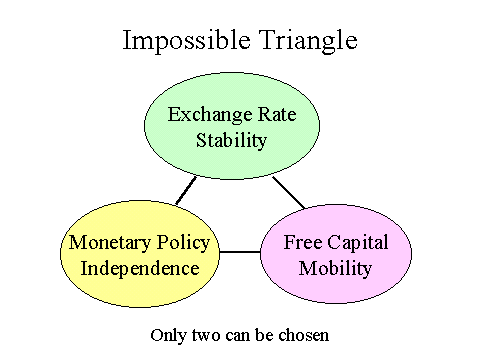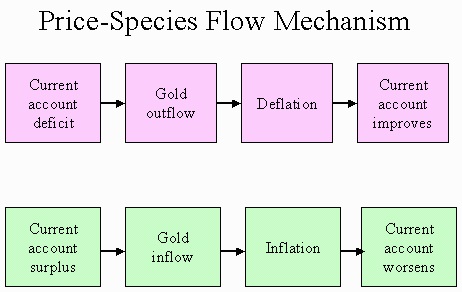
(See handout no.2)
As we begin to discuss the history of international monetary systems in this and the next two lectures, four general features are worth emphasizing at the outset.
(1) The international monetary system (how exchange rates, balance of payments and macroeconomic management are managed and adjusted globally) is part of a broader international regime. As such, it is influenced strongly by the way power is distributed and exercised in the world, as well as the presence or absence of a powerful and reliable leader country.(2) Over time, international monetary systems exhibit oscillation between two opposites: for example, (i) general floating versus general fixity, (ii) stability versus instability, and (iii) free capital mobility versus no such mobility. It is hard to say which situation is normal and which is abnormal. People often believe that the prevailing system is normal and permanent, but it usually isn't. Whether capital mobility has become irreversible in the 21st century is an interesting and open question.
(3) "The triangle of impossibility": Consider (i) exchange rate stability (i.e., fixed exchange rates), (ii) monetary policy independence, and (iii) free capital mobility. These three things are regarded as desirable, but only two can be realized at any time. Different international monetary systems emerge depending on which one we give up. For example, if we abandon the first, we have a floating rate system; and if the second is removed, monetary union like EU will emerge, and so on.(4) Since the 19th century, there has been a gradual movement away from commodity money (typically gold) toward paper money (managed currency). The problem with gold is its quantity is too constraining, which is also a merit if the central bank is irresponsible. In the 21st century, maybe we will have e-money which has completely new characteristics (and risks).

From the 19th century to present, the major international monetary systems have evolved as follows.
Gold standard, until 1914 (fixed rates under UK dominance): throughout most of the 19th century and up to 1914 (outbreak of WW1), the world was on a gold standard. Especially, the period of 1879-1913 was called the Classical Gold Standard (or International Gold Standard) because all major countries participated in it. Trade was liberalized and capital was mobile.Interwar period: after WW1, the world powers tried to return to the gold standard at prewar parities (i.e., at the previous exchange rates), but the attempt to restore gold convertibility did not succeed, except momentarily. The 1920s-30s were characterized by recessions, banking crises, the Great Depression and the rise of fascism. Exchange rates were mostly floating and protectionism increased. There was a hegemonic power shift from the UK to the US.
Bretton Woods system, 1950s-1971 (US-centered fixed rates): Under the international dollar standard, the world economy experienced high growth, price stability and movement toward freer trade. Unlike the gold standard days, however, there were severe restrictions on private capital mobility.General floating and attempts to reduce instabilities, 1973-: After the transition period of 1971-73, the major currencies started to float. Soon, it was discovered that currency sometimes fluctuated too much. Crises and calm periods alternated. Overshooting, currency crises and massive capital flows became common. From 1985, major countries occasionally intervened jointly to correct currency levels. At the same time, European countries strived to create a unified currency in steps, which was achieved in 2002.
Since the late 19th century to present, broad developments in prices and long-term interest rates were as follows.
Inflation was most stable during the Bretton Woods period, with WPI inflation in major countries staying almost at zero for a few decades (particularly early 1950s to mid 1960s). The 19th century gold standard also experienced relative price stability, although long- and medium-term price swings (which were synchronous across all countries) existed. In the 1970s, inflation accelerated with different rates of price increase across countries. But since the late 1980s and up to present, high inflation subsided (except in a small number of developing and transition countries). The world faces a relative price stability again, even a deflationary trend in some countries including Japan.
Long-term interest rates on government and corporate bonds were very stable during the gold standard period. But they became unstable and internationally divergent after the 1960s, especially the inflationary period of the 1970s-80s. At present, interest rates remain different across countries even though the world is financially integrated.
This was also a period of imperialism and colonialism by the Western powers. At the same time, the latecomers (US, Germany and Japan) were rapidly catching up with the UK.
As a developing country, Japan joined the gold standard somewhat later, in 1897. For details, see lecture 6 of Economic Development of Japan.
Salient features of the Classical Gold Standard were as follows.
(1) Goods market integration under free trade: international price linkage was strong, and the world experienced common price movements and business cycles. The law of one price (the same products bear the same price in different locations) held in many commodities, and this fact can also be confirmed by econometric studies. However, one problem was the absence of the nominal anchor (see below). This means that no country, organization or mechanism played the role of stabilizing the global price level. As a result, there was globally common price fluctuations in the medium and long run.(2) Financial integration under free capital mobility: the private sector could issue, sell or buy foreign stocks and bonds freely. US railroad bonds were particularly popular as a means to convert British saving into American investment. Free capital movement resulted in strong interest rate linkage. Short-term interest rates were volatile while long-term interest rates were extremely stable, and these interest movements were internationally synchronized. British interest rates always provided the floor (i.e., they were lowest) for the rates of other countries, because British securities had highest liquidity and lowest risk premium, and because London was the financial center of the world. Another interesting point was that current account "imbalances" were huge relative to (estimated) GDP. This means that some countries lent while others borrowed according to their saving-investment balances. And this was not a disequilibrium. Furthermore, banking crises tended to occur simultaneously across countries.
(3) Fixed exchange rates: for 35 years, there was no realignment of major exchange rates. In those days, the exchange rate was called the "gold parity" which was the conversion ratio between the home currency and an ounce (31.10 grams) of gold. The cross rates between two currencies could be calculated as the ratio of two gold parities.(4) Macroeconomic fundamentals were not stable: although integrated in trade and finance, the world economy was far from stable, from the viewpoint of macroeconomy. There were booms and busts, and severe recessions were experienced. Financial crises and bank runs were common.
A nominal anchor is a mechanism to stabilize nominal variables, especially the general price level. More plainly, it is a mechanism to prevent inflation or deflation. This can be an informal policy rule adopted by the central bank, such as the Taylor's rule (US short-term interest rate policy responds to domestic inflation and unemployment). It can be a legally binding commitment such as inflation targeting. It may depend on the wisdom of the central banker, for example, like Mr. Alan Greenspan. Alternatively, it can be an automatic mechanism. The nominal anchor can be domestic or global. Here, we are discussing the nominal anchor for the entire world. The point is that no one ensured the price stability of the gold standard world--neither the UK government, the Bank of England, the City, nor the supply and demand of gold.
Sherlock Holmes was a famous London detective in the novels written by Sir Arthur Conan Doyle (1859-1930). Dr. John Watson was his friend and assistant. In the adventure stories of Sherlock Holmes, we can find many references to foreign securities and investment. For example, the adventure entitled "The Dancing Men" (1903) begins as follows.
|
Holmes had been seated for some hours in silence with his long, thin back curved over a chemical vessel in which he was brewing a particularly malodorous product. His head was sunk upon his breast, and he looked from my point of view like a strange, lank bird, with dull gray plumage and a black top-knot. "So, Watson," said he, suddenly, "you do not propose to invest in South African securities?" I gave a start of astonishment. Accustomed as I was
to Holmes's curious faculties, this sudden intrusion into my most intimate
thoughts was utterly inexplicable. |
Apart from econometric studies, I think this can be presented as a strong evidence that Dr. Watson (and other ordinary citizens) often invested in foreign securities.
Although there was no internet in the late 19th century, the trans-Atlantic cable guaranteed that the financial markets in London and New York were integrated on a real-time basis.
There are two important terms associated with the gold standard. The first is the "rules of the game," and the second is the "price-species flow mechanism."
The rules of the game means a set of rules of conduct, often implicit but nonetheless binding, that are expected of the participating members of a certain system. In the case of the Classical Gold Standard, the participating countries were required to observe the following rules:
Gold parity. Each country must declare a fixed value ratio between gold and domestic currency. For example, 1 ounce of gold = 20.69 US dollars, 1 ounce of gold = 4.24 British pounds, and so on. This establishes the cross ratio of 1 British pound = 4.87 US dollars.Convertibility to gold (domestic convertibility). All paper money must be exchanged freely to gold at the declared gold parity, if the bearer brings it to the central bank. Usually this promise was clearly printed on bank notes. In those days, convertibility meant convertibility to gold (today, it means convertibility to international currencies such as dollar, euro and yen).
Free international gold movement (international convertibility): there should be no restriction on the exportation or importation of gold as a commodity as well as a payment method. This guaranteed free monetary mobility based on demand and supply conditions. The requirement that the government should not prevent the loss (exportation) of gold was particularly important.Interest rate policy: if a country began to lose gold through a balance-of-payments deficit, it was expected to raise short-term interest rates to attract back the monetary metal. Conversely, if it is gaining gold, short-term interest rates must be lowered to repel the gold inflow. By this symmetrical operation, it was thought that the monetary authority could assist international adjustment. (But whether that really worked is an open question, as discussed below.)
Prof. Ronald McKinnon (Stanford University) spelled out the rules of the game for other international monetary systems, including the Bretton Woods system, general floating until 1985, general floating after 1985, EMS, etc. If interested, see the book in the reference section.
Here, price means inflation or deflation. Species (true money) means gold. So this funny term really means a "mechanism linking inflation/deflation with gold flows."
Through this mechanism, it was thought that the gold standard had a wonderful built-in adjustment mechanism. Even if governments did nothing, international macroeconomic adjustment would occur automatically, or so it was argued. It works like this:
If a country has a current account deficit for any reason, there will be an outflow of gold. The loss of gold means less money supply, so this country will have a price deflation. After some time, its products become cheaper in the global market, so exports will rise and imports will fall. This improves the current account.It works just the opposite for a country with an initial current account surplus. It will accumulate gold, which increases money supply and raises the price level. The country loses price competitiveness, so the trade balance worsens.

In either case, there is a change in the price level that automatically offsets the initial current account imbalance. There is no need for central bank action or international policy coordination. In fact, the US did not even have a central bank until 1913!
Although this mechanism is still taught today as a key feature of the gold standard, whether it really functioned like this is highly questionable. Evidence strongly suggests otherwise.
The biggest problem with this explanation is its total neglect of capital mobility; it is focused on the current account and price competitiveness only. But in a financially integrated world with firmly fixed exchange rates, a tiny difference in interest rates will prompt a huge and immediate private capital flow. Moreover, the current account is just a mirror image of the capital account (with the opposite sign). Therefore, as long as the country continues to lend or borrow, there is no need for the current account to "balance."
In fact, throughout the 19th century, the UK always had a current account surplus (except for a few years), which rose to as high as 8% of GNP just before WW1. The US, a young developing country with vast investment opportunities, continuously had a current-account deficit and a strong capital inflow until around 1895. Germany was constantly in surplus while Sweden was constantly in deficit, except for a few years. All this reflected each country's long-term saving-investment balance.
Moreover, since private capital moved swiftly to offset any balance of payments shocks, there was no need to ship gold across the Atlantic Ocean (though some gold shipment actually occurred). The overall balance of payments (=current account + capital account) could be kept near zero instantaneously as long as capital was mobile.
The Classical Gold Standard was shattered by the outbreak of WW1. The system collapsed not because of an internal dilemma but because of an external violence. As soon as the fighting began in Europe, private trade and financial transactions were suspended. Gold exports were banned. As international linkage disappeared, each country started to issue bonds and print money to finance the war effort. They began to have different inflation rates.
When WW1 ended, the major countries wished to restore the prewar gold standard, which seemed to offer prosperity and stability. "Return to gold" became the national and even global slogan, and it was believed that returning to gold at the prewar parities (i.e., at the previous exchange rates) was the right thing to do. A report was published, and a few important international conferences were held for this purpose (UK's Cunliffe Report, 1919; conferences in Brussels 1920, in Genoa 1922).
The US returned to gold early, in 1919. The UK returned in 1925. Most other European states also returned by 1928, so it looked like the gold standard was resurrected. But this system lacked leadership and coordination, and turned out to be fragile and short-lived. As France demanded only gold for international settlements, a speculative downward pressure on the UK pound emerged. In 1931, the UK abandoned the gold standard again, and the other countries followed. In the midst of the Great Depression (1929-), countries began to form trade blocs and protected their internal markets. Global trade continued to shrink. Militarism and fascism rose.
Japan returned to the gold standard in January 1930 and abandoned it in December 1931. For more details, see lecture 7 of Economic Development of Japan.
Why did the attempt to restore the gold standard in the interwar period fail?
First, the 1920s and 30s saw frequent recessions and banking crises (exception: the US economy was booming until 1929). It was thought that governments had first and foremost the responsibility to solve the domestic problems of bankruptcy and unemployment, rather than keeping international commitments. Inward-looking attitude became dominant.Second, there was a leadership vacuum in the international regime. The UK, the old leader, was losing power and incapable of handling the situation. The US, the new leader, would not assume the responsibility yet. During the transition period, no one watches over big issues.
Third, as a result of this and in the absence of policy cooperation, each country became selfish. Protectionism and competitive devaluation escalated. Under such circumstances, the restoration of the prewar international monetary system was impossible.
 During this period, the famous British economist John Maynard Keynes argued
against returning to gold (this was in 1925, before he wrote the famous General Theory in
1936). His argument was roughly as follows:
During this period, the famous British economist John Maynard Keynes argued
against returning to gold (this was in 1925, before he wrote the famous General Theory in
1936). His argument was roughly as follows:
At the prewar parity, the pound would be 10% overvalued against the dollar because of the inflation gap between the UK and the US since 1914. If the UK returned to gold at the old exchange rate, the tradable sector (especially the coal industry) would have to suffer severely.Moreover, from a historical perspective, the gold standard was a "barbaric relic" (i.e., crude and outdated system) and should be abandoned. The value of money should not be subjected to the demand and supply of gold which was uncontrollable. The world should move to paper currency managed scientifically and responsibly by central banks.
<References>
Bordo, Michael D., and Anna J. Schwartz, eds, A Retrospective on the Classical Gold Standard, 1821-1831, The University of Chicago Press, 1984.Eichengreen, Barry, ed, The Gold Standard in Theory and History, Methuen & Co. Ltd, 1985.
Keynes, John Maynard, "The Economic Consequences of Mr. Churchill," 1925 (reprinted in his Essays in Persuasion).
McKinnon, Ronald I., The Rules of the Game: International Money and Exchange Rates, MIT Press, 1996.